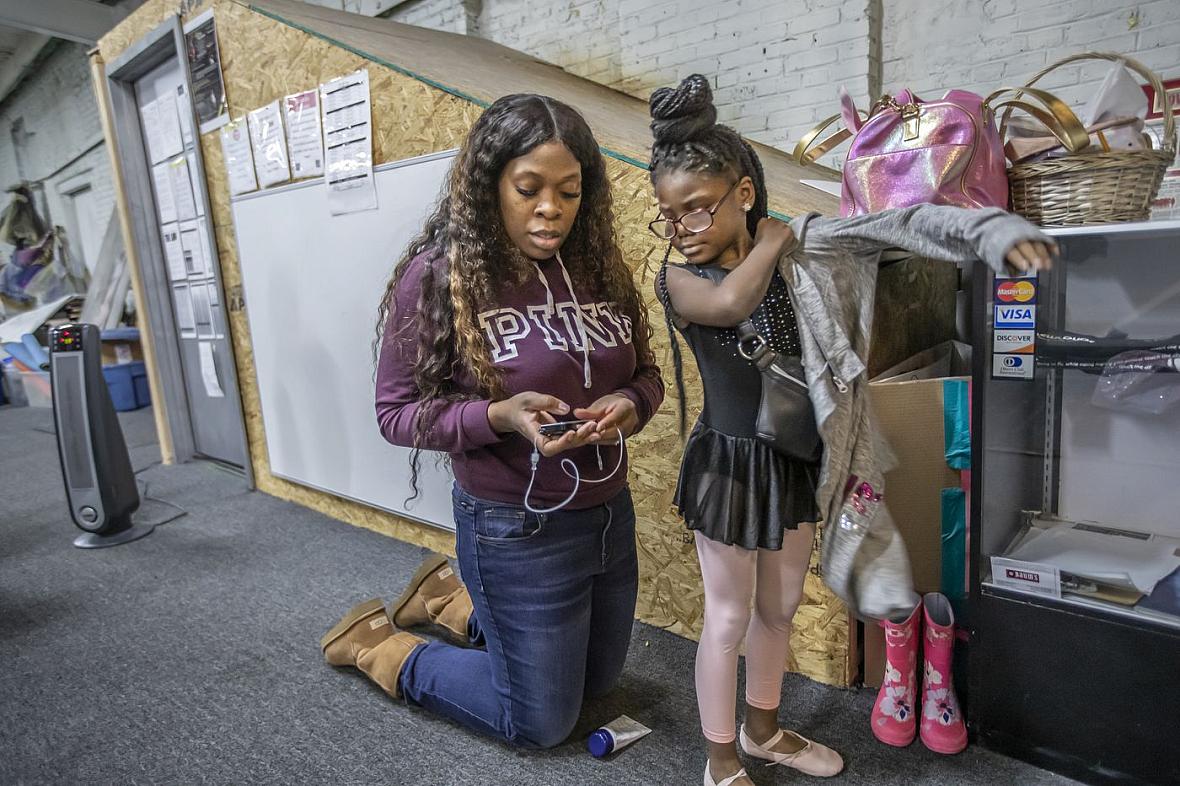Stewart, as both a mother and a nurse, has seen such disconnects.
“I speak up, I make sure they do everything they’re supposed to do,” Stewart said. “I definitely feel like McKenzie is at an advantage because I’m a nurse and an advocate for her. I worry about people who don’t have that.”
One example is her 21-year-old cousin in West Philadelphia, who found out she had type 1 diabetes through a phone call from her doctor. The doctor later ordered her a continuous glucose monitor, which automatically tracks blood-sugar levels and can make managing diabetes much easier — if you know how to use it. But the device was delivered in the mail, with no doctor or pharmacist to walk her through its setup.
Six-year-old McKenzie, by contrast, learned from her care team at Children’s Hospital of Philadelphia to make careful glucose control just another part of her busy life. Yes, she has her mother’s constant advocacy. But the family also benefited from a full week at the hospital — standard procedure in Philadelphia when a child is diagnosed with type 1 — full of lessons for both McKenzie and her parents.
On a recent Saturday morning, McKenzie finished ballet class, pranced across the room, and launched into her father’s arms for a quick hug.
With moments to spare before jazz class, she dug into her glitter-encrusted unicorn gym bag and pulled out a zippered kit the size of an iPad containing a monitor and needles, and handed it to her father, Christopher.
As the rest of the girls buzzed around the room, McKenzie sat patiently as he tested her blood sugar. She gobbled down a peanut butter sandwich — she needs to eat a snack and balance her insulin when exercising — rested a beat, then dashed back to her place on the dance floor.
Addressing race-based communication challenges requires doctors to recognize and confront what’s known as implicit bias, beliefs that may be held unknowingly, yet exercise considerable power.
Dan Taylor leads the outpatient pediatrics clinic at St. Christopher’s Hospital for Children. He has devoted his career to caring for his young patients, most of whom hail from the poorest neighborhoods in Philadelphia. He has published widely — including in this newspaper — on how growing up in tough circumstances can set up his young patients for lives of failure unless there are serious interventions to help them plot a better course.
Yet when he took an online bias test offered by Harvard, he was stunned to discover that he viewed white and black patients differently. The test measures how strongly test-takers associate groups of people with various qualities, such as intelligence, athleticism, and goodness. People who quickly connect positive qualities with white and black people equally are considered less biased than those who take longer to make those links.
The realization has changed how he approaches his patients and the Drexel medical students he supervises. But even for a highly motivated physician such as Taylor, it’s not simple.
“It’s a different way of retraining your brain to listen a different way, to pay attention to very subtle expressions or words or emotions that families express,” Taylor said.
And unconscious bias is about even more than that.
Steven Willi, medical director of the diabetes center at CHOP, found that unconscious bias among doctors prescribing insulin pumps likely leads to fewer black children getting the technology, which helps patients keep blood-sugar levels more stable than periodic injections.
In a 2015 study, Willi and his colleagues found that white children from low-income families without private insurance were more likely than black children from wealthier families with private insurance to have this technology.
There are reasons a child may not want an insulin pump: Teenagers may not want to wear a bulky device, while parents may worry about whether the technology is reliable, or whether it’s just another costly gadget.
“Or it may just be you weren’t offered the pump,” Willi said.
“And ‘offered’ can mean a lot of things: ‘Oh, do you think you might be interested? No? OK, that’s fine,’ vs., ‘I really think this is something you should be taking advantage of,’” he said. “In the relationship between the practitioner and the patient, there is a great deal of salesmanship — and implicit bias must influence that.”
Years ago, when the technology was newer and harder to get insurers to cover, there was a sense that patients needed to “earn” a prescription. And implicit bias, Willi believes, played a role in which patients doctors decided were worthy.
“Some kids will do well with the pump, and you can’t always predict it. We thought we could predict it,” he said. “What I learned ... is that everybody has the opportunity to do well. It changed my outlook entirely.”
The Stewarts didn’t wait for someone to offer McKenzie an insulin pump.
After a year of pricking her finger multiple times a day to test her blood sugar, giving her insulin injections, watching everything she ate, and worrying every time she wanted to run around outside in their South Philadelphia neighborhood, Menda told McKenzie’s doctors she wanted her daughter to have an insulin pump.
McKenzie’s doctors agreed and helped her enroll in a clinical trial that would get her an insulin pump and continuous glucose monitor sooner than she would have qualified for them through insurance.
With the pump and CGM, McKenzie is down from as many as eight needles a day to a few a week, to calibrate her devices or test her levels on occasions, such as dance, when she takes them off.
Most important, having the technology gives the Stewarts confidence to let McKenzie be a kid first, and a type 1 patient second.
“It’s very important to me that she feels like the other kids her age,” Stewart said. “Just because you have diabetes doesn’t mean you’re different than anyone else.”
[This article was originally published by The Inquirer.]


